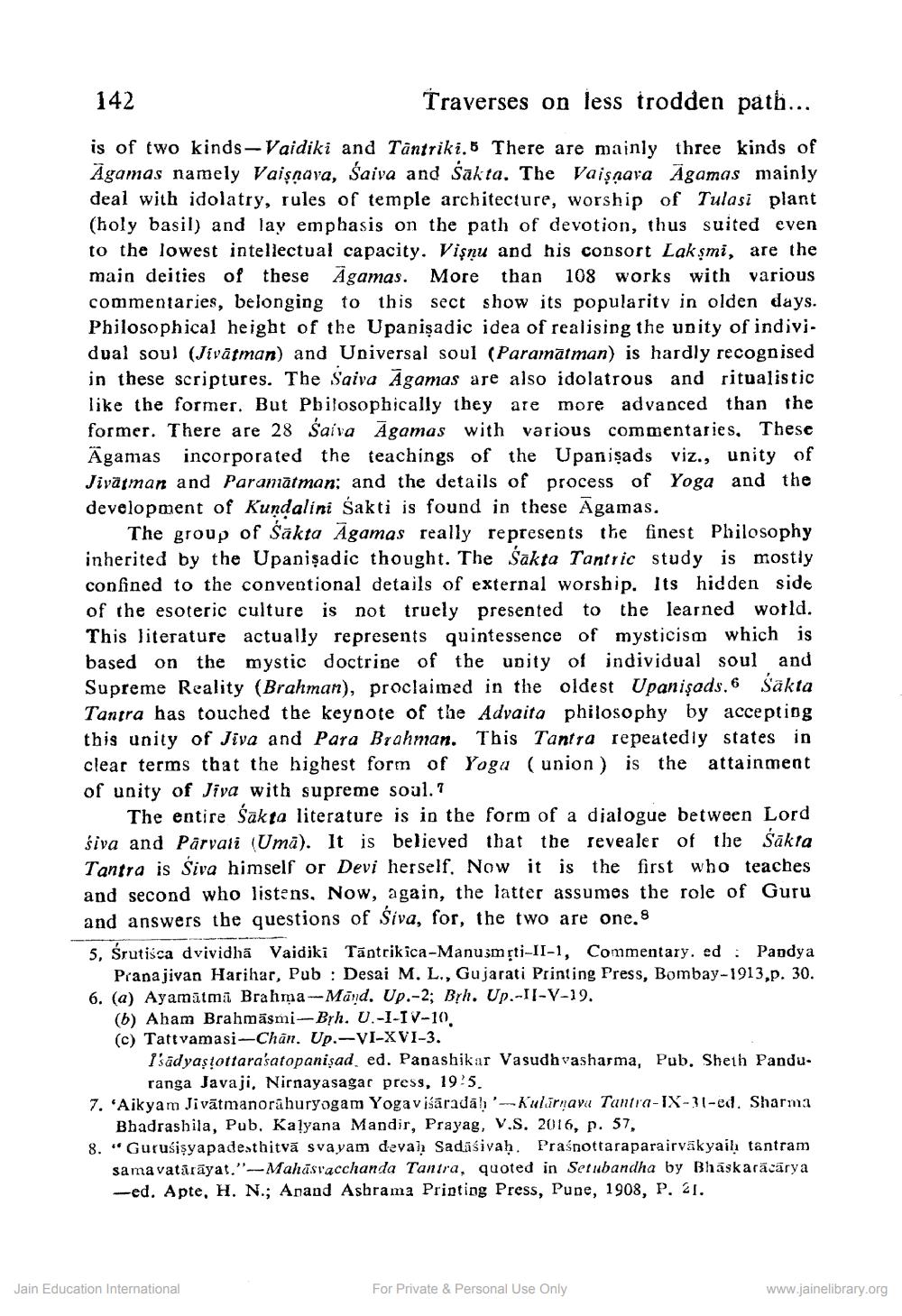________________
142
Traverses on less trodden path...
is of two kinds-Vaidiki and Tantriki.5 There are mainly three kinds of Agamas namely Vaiṣṇava, Śaiva and Sakta. The Vaisnava Agamas mainly deal with idolatry, rules of temple architecture, worship of Tulasi plant (holy basil) and lay emphasis on the path of devotion, thus suited even to the lowest intellectual capacity. Vişnu and his consort Laksmi, are the main deities of these Agamas. More than 108 works with various commentaries, belonging to this sect show its popularity in olden days. Philosophical height of the Upanisadic idea of realising the unity of individual soul (Jivātman) and Universal soul (Paramatman) is hardly recognised in these scriptures. The Saiva Agamas are also idolatrous and ritualistic like the former. But Philosophically they are more advanced than the former. There are 28 Saiva Agamas with various commentaries. These Agamas incorporated the teachings of the Upanisads viz., unity of Jivätman and Paramatman; and the details of process of Yoga and the development of Kundalini Sakti is found in these Agamas.
The group of Sākta Āgamas really represents the finest Philosophy inherited by the Upanisadic thought. The Sakta Tantric study is mostly confined to the conventional details of external worship. Its hidden side of the esoteric culture is not truely presented to the learned world. This literature actually represents quintessence of mysticism which is based on the mystic doctrine of the unity of individual soul and Supreme Reality (Brahman), proclaimed in the oldest Upanisads. Sakta Tantra has touched the keynote of the Advaita philosophy by accepting this unity of Jiva and Para Brahman. This Tantra repeatedly states in clear terms that the highest form of Yoga (union) is the attainment of unity of Jiva with supreme soul.7
The entire Sakta literature is in the form of a dialogue between Lord siva and Parvati (Umā). It is believed that the revealer of the Sākta Tantra is Siva himself or Devi herself. Now it is the first who teaches and second who listens. Now, again, the latter assumes the role of Guru and answers the questions of Siva, for, the two are one.8
5, Śrutisca dvividha Vaidiki Tantrikica-Manusmrti-II-1, Commentary. ed Pandya Pranajivan Harihar, Pub: Desai M. L., Gujarati Printing Press, Bombay-1913,p. 30. 6. (a) Ayamātmā Brahma-Mand. Up.-2; Brh. Up.-II-V-19.
(b) Aham Brahmasmi-Brh. U.-I-IV-10,
(c) Tattvamasi-Chan. Up.-VI-XVI-3.
Isadyaṣṭottara'satopaniṣad ed. Panashikar Vasudhvasharma, Pub. Sheth Pandu
ranga Javaji, Nirnayasagar press, 19:5.
7. 'Aikyam Jivātmanorahuryogam Yogaviśaradāḥ'-Kulārṇava Tantra-IX-31-ed. Sharma Bhadrashila, Pub. Kalyana Mandir, Prayag, V.S. 2016, p. 57,
8. "Gurusisyapadesthitva svayam devah Sadasivaḥ. Praśnottaraparairväkyaiḥ tantram sama vatārāyat."-Mahāsvacchanda Tantra, quoted in Setubandha by Bhaskaracārya -ed. Apte, H. N.; Anand Ashrama Printing Press, Pune, 1908, P. 21.
Jain Education International
For Private & Personal Use Only
www.jainelibrary.org




